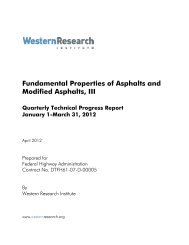Fundamental Properties of Asphalts and Modified Asphalts, III
Fundamental Properties of Asphalts and Modified Asphalts, III
Fundamental Properties of Asphalts and Modified Asphalts, III
Create successful ePaper yourself
Turn your PDF publications into a flip-book with our unique Google optimized e-Paper software.
Work Conducted This Quarter<br />
A Topical Report, anticipated to be delivered early in the next quarter, summarizes findings from<br />
the past two to three years <strong>of</strong> research. This report describes the present state <strong>of</strong> practice for the<br />
investigation <strong>of</strong> the compositional nature <strong>of</strong> asphalts <strong>and</strong> aggregates, as studied by atomic force<br />
microscopy <strong>and</strong> presents modeling approaches for integrating asphalt/aggregate physichemical<br />
properties into continuum-damage models <strong>of</strong> pavement performance. Finally, this report will<br />
suggest how work elements from the ARC work plan; ARC Work Element Subtask M1b-2-<br />
Work <strong>of</strong> Adhesion at Nano-Scale using AFM, ARC Work Element Subtask M2a-2-Work <strong>of</strong><br />
Cohesion Measured at Nano-Scale using AFM, Work Element Subtask F1d-7-Coordinate with<br />
AFM Analysis, <strong>and</strong> Work Element F3a-Asphalt Microstructural Modeling [Western Research<br />
Institute 2008], will be coordinated with this task.<br />
Work Plan Next Quarter<br />
• Research conducted to date in this subtask has been primarily concerned with defining<br />
<strong>and</strong> measuring compositional properties <strong>of</strong> material thin-films which exhibit <strong>and</strong>/or cause<br />
crazing phenomena. This is thought to be a result <strong>of</strong> material discontinuity<br />
(heterogeneity) caused by variations in wax <strong>and</strong> asphaltene content in the film. It is<br />
hypothesized that this heterogeneity may be considered an indicator <strong>of</strong> cracking <strong>and</strong><br />
embrittlement in asphaltic materials. Thus, a natural avenue for future research would<br />
then be to conduct measurements at micron <strong>and</strong> nano-scale that focus more on<br />
physical/rheological properties <strong>of</strong> thin films related to the stiffness <strong>and</strong> embrittlement<br />
propensity, in addition to continuing compositional/chemical characterization <strong>of</strong> these<br />
materials, in order to draw correlations between compositional <strong>and</strong> rheological properties.<br />
• In the next quarter, a revised SARA separation method will be employed to separate<br />
asphalt into saturate, aromatic, polar aromatic, <strong>and</strong> asphaltene fractions. In this<br />
procedure, iso-octane asphaltene/maltene separations will be conducted, <strong>and</strong> the maltenes<br />
from this separation will be further separated employing the modified SARA separation<br />
procedure. Based on the information gained from these studies, a revised method for<br />
ASTM 4124 will be submitted to the ASTM D4 committee for approval.<br />
• A solidification stage is being assembled as part <strong>of</strong> the atomic force microscope by<br />
employing both a heating stage <strong>and</strong> a cooling stage fabricated along with micrometer<br />
positioning devices, figure 2-3.2. This apparatus will be used to impart a thermal<br />
gradient across an asphalt thin-film resulting in a moving solidification front (liquidsolid)<br />
interface that may be monitored in time with AFM. Furthermore, an automated<br />
wetting apparatus will also be assembled to better control the spin casting procedure <strong>and</strong><br />
to observe <strong>and</strong> quantify lubrication dynamics (see figure 2-3.3). Finally, metrology <strong>and</strong><br />
nanoindentation accessories have been added to the existing AFM equipment to enhance<br />
capabilities to include micro/nano-rheological testing <strong>of</strong> material thin-films.<br />
50





